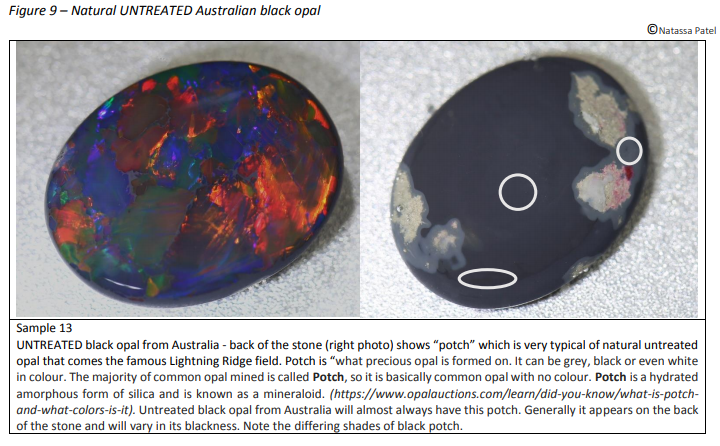
加工されたオパールか偽物のオパールを見分ける方法
 しばらくの間、処理済みのウェロ産オパールが天然ブラックオパールとして流通していることを懸念していました。インターネット上には、エチオピア産の処理済みオパールが誤って掲載されているケースが数多くあります。同様に重要なのは、オーストラリアの小売店や、残念ながらオパール採掘場でも販売されていることです。AIGSタイ校で宝石学の優等学位を取得しているナターシャ・パテル氏に、オパール採掘場や実験室検査機器を利用できない状況で、石が天然か処理済みかを見分ける方法について調査を依頼しました。
しばらくの間、処理済みのウェロ産オパールが天然ブラックオパールとして流通していることを懸念していました。インターネット上には、エチオピア産の処理済みオパールが誤って掲載されているケースが数多くあります。同様に重要なのは、オーストラリアの小売店や、残念ながらオパール採掘場でも販売されていることです。AIGSタイ校で宝石学の優等学位を取得しているナターシャ・パテル氏に、オパール採掘場や実験室検査機器を利用できない状況で、石が天然か処理済みかを見分ける方法について調査を依頼しました。
これは、Natasha Patel の研究レポート「天然ブラックオパール - 正しい質問をしていますか?」のコピーです。
「天然ブラックオパール」という言葉は、私たちが思っているほど明確ではない場合があります。
オパールは天然ですか?はい
オパールは黒ですか?はい
これらの言葉のどこにも、ブラックオパールの黒色が天然由来のものかどうかは言及されていません。ここ数年、市場にはエチオピア産の染色、燻製、砂糖酸処理されたブラックオパールと呼ばれるものが溢れています。これらの処理工程に関する文献は曖昧で不完全です。業界は処理方法を判断するために場当たり的な方法に頼っています。本調査、分析、議論の目的は、ブラックオパールの黒色が人為的な処理や工程によるものかどうかを判断することです。
正しい質問は、 「ブラックオパールは処理されていますか?」です。
なぜこの質問をするのでしょうか?それは価値です。お客様は、オーストラリア産の天然の未処理ブラックオパールを購入していると思い込んで騙されていますが、実際には、ほとんどの場合、黒色にするために大幅に加工されたクリスタルオパールを購入しているのです。処理済みブラックオパールと未処理ブラックオパールの価格差は最大500%にも及ぶことがあります。
https://www.gia.edu/doc/WN11.pdf(79ページ)には、地球から採取された原石と最終的な結果の大きな違いを示すビフォーアフターの写真が掲載されています。注意すべき点として、原石のオパールであっても、透明な結晶/白から黒やそれに似た色合いに変化する加工が施されることがあります。
エチオピア産の処理済みブラックオパールは、卸売市場では1カラットあたり約10ドルで販売されています。全く同じように見える未処理のブラックオパールは、1カラットあたり最大5,000ドル、場合によってはそれ以上の価格で取引されることもあります。

基本事項
ブラックオパールは、取引においてダークボディトーンの石と呼ばれることもあります。天然の未処理ブラックオパールは主にオーストラリア産ですが、エチオピア、アメリカ合衆国、チェコ共和国、ハンガリー、メキシコ、そして最近ではインドネシアでも発見されています。
オパール業界の採掘業者、卸売業者、そしてトレーダーにとって、黒くなるように加工されたオパールと天然の黒色オパールが混同されている問題は極めて重要です。この場合、真実を隠蔽することは嘘をつくのと同じです。オパールを購入しようとしている人々は、誤った情報と、本当に何を質問すべきかという知識の欠如によって、不当に利用されています。加工されたブラックオパールにも市場における地位があると考える人もいるかもしれません。私個人としても、そしてほとんどのオパール供給業者もその意見に賛成です。しかし、その市場シェアが虚偽や誤解を招く情報に基づいていないことは不可欠です。
このレポートの目的は、以下の問題に対処することです。
1. 天然ブラックオパールは、石の本体色を透明から黒色に変える処理が施されている場合があることを理解してください。覚えておくべき重要な点は、「未処理の天然ブラックオパール」です。
2. ブラック オパールに不慣れな人向けに、処理済みのブラック オパールと未処理のブラック オパールを認識して区別するためのガイドラインとテクニックを提供します。
3. ブラックオパールのボディカラーは、処理による完全かつ直接的な結果である可能性があるので、少なくとも注意してください。
4. オパールを購入する際に、現場や市場の近くで有名なラボが利用できない場合があります。
5. ブラックオパールは、著名な鑑定機関が処理の有無を確認するために請求する料金を正当化できない可能性があります。6. 顕微鏡や紫外線分光計などの大型の宝石学機器を利用できない可能性があります。

天然ブラックオパールの処理の有無を見分ける方法を検討するため、15個のサンプルを簡易な方法(現地調査)で検査しました。結果は本報告書末尾の付録Aに掲載しています。サンプルには、オーストラリア、エチオピア、インドネシア産のブラックオパール(処理済みおよび未処理)が含まれています。なお、宝石学的検査により、15個のサンプルすべてが天然であることが診断的に証明されています。
実施されるテストでは、次のような、宝石を購入するときに持ち運んだりアクセスしたりできる簡単なツールが使用されます。
トーチ
規模
水を入れた中間色の容器
ループ/バイザー
ペン/鉛筆
曲げられるワイヤーまたは紐
処理されたエチオピア産ブラックオパールの検出の概要
未処理のブラック/ダークエチオピアオパールのボディカラーは、全く黒くありませんでした。光とループの下で観察すると、非常に濃い茶色でした。
すべての産地の未処理オパールには、サンプル全体が完全に透明だった染料/燻製処理済みのエチオピア産オパールとは異なり、不透明(透けて見えない)または半透明(完全な透明性がない)の石が含まれていました。
エチオピア産の処理済みブラックオパールのほとんどは、強い黄色の光を石の近くや下から透過すると、深いチェリーレッドの透明度を示します。
処理されたブラックオパールサンプルの比重は平均よりも著しく低くなっています。
ブラックオパールの処理の指標は、水に浸すとより見やすくなります。
処理済みのブラック オパールのほとんどには染料/燻製の跡が見られ、ブラック オパールの黒は天然由来ではないことがわかります。
携帯電話のカメラを使用して、石の物理的な外観を詳しく観察すると、処理を検出するのに役立ちます。
必ず白色光を使用してください。白色光は(人間の目には)黄色に見え、可視光線の全スペクトルを網羅しているため、石の真の色を見分ける上で重要です。
ブラックオパールは地球上で最も希少な宝石の一つです。まずは慎重に
-石が大きくドーム状になっている場合
-石全体が色付きの場合(色の遊びが石の前面、背面、側面で見られます)。
高いドームとフルカラーの組み合わせは、天然の未処理のブラックオパールでは非常に稀です。

テスト結果の分析から得られた結論
1. 光とルーペによる体の色とマトリックスの視認性
a.天然の未処理ブラックオパールは、強い光とルーペで見ると、地色が実際には黒ではないことがわかります。通常、非常に濃い茶色または灰色です。色に気を取られた場合は、色が全くないか、最も少ない部分に注目してください。
b.未処理の「ブラックオパール」サンプルにはすべて、母岩(母岩または無色/一般的なオパール)とインクルージョンが含まれていました。母岩と有色オパールの硬度の差は非常に大きく、処理を施すと石が割れる可能性があります。
ボディカラーが漆黒で、マトリックスが全く存在しない場合は注意が必要です。マトリックスが存在するからといって、処理されていないということではありませんのでご注意ください(処理済みのブラックオパールの中には、マトリックスが存在するものもあります)。図1のサンプル3と5は、ボディカラーが漆黒になる良い例です。
2. 透過光(下からの懐中電灯光源)を使用した場合の石のボディカラーの変化
このテストは非常に簡単で、ブラックオパールの黒色の起源について注意を払うべきかどうかを判断する出発点となります。白色光(可視光線全域を含む黄色)を軽く当てます。懐中電灯と石をできるだけ近づけます。石をあらゆる角度から観察します(裏返しにして裏面を上に向けます)。小さな石に適したテストです。
a.処理されたエチオピアのサンプルの体色はすべて、透過光(光源(懐中電灯)の下からの)で観察すると完全に透明(透けて見える)になりました。
b.さらに重要なのは、透明な色合い、つまりはっきりとしたチェリーレッドが見えたことです。
c.その他の天然の黒/濃いオパール(透明な場合)は、より黄色/灰色の透明なボディカラーを示します。
d.未処理のサンプルはすべて部分的に透明であり、ほとんどの場合完全に不透明でした。
下からの光源で見るとオパールの透明度がチェリーレッドに変化する場合は注意してください。
透明度の色の違いは下の写真から一目瞭然です。

3. 比重試験
比重は、宝石の大きさに対する重量の比です。宝石はそれぞれ比重が異なり、この検査は大小を問わずあらゆる宝石研究所で日常的に用いられています。計算式は以下のとおりです。

オパールの比重は平均2.12で、範囲は1.75~2.23です。処理済みのエチオピア産ブラックオパールのサンプルは、一貫してスケールの下限に近い値を示しました(付録A参照)。いずれのサンプルも平均2.12を大きく下回る値を示しました。エチオピア産の処理済みオパールはすべて比重が1.75に近く、未処理のブラックオパールはすべて比重が2.0に近づきました。
比重測定キットを作るためのDIYリソースは、インターネット上に数多くあります。信頼できる宝石検査機器メーカーも、手頃な価格でキットを販売しています。少なくとも0.01カラット(小数点以下2桁)まで読み取り可能で、分解能も少なくとも0.01カラット(1カラットの0.01の精度)のカラットスケールを使用してください。宝石の比重が2.12よりも1.75に近い場合は注意が必要です。
4. ダンクする – 「没入型」
中性色の容器に入れた水に石を完全に浸すと、処理の判断がはるかに容易になります。完璧ではないかもしれませんが、ほぼ確実です。
染料や煙による痕跡(黒色の濃淡)がより目立ちます。ルーペやバイザーを用いて、水中ですぐに強い白色光に当てて石を観察してください。石を水中に沈めておく時間が長くなるほど、処理の痕跡が消えてしまうことがあります。石体色が濃くなり(黒色がより黒くなり)、遊色効果がより強く現れ、痕跡が目立たなくなります。
浸漬と強い光を使った技法は、石本来の色合いを際立たせるのにも役立ちます。以下の画像と説明は、石の選び方のヒントとなるでしょう。








5. 携帯電話のカメラ(マクロレンズはオプション)
最近の携帯電話のカメラは、ズーム撮影が得意です。スマートフォン用のマクロレンズアダプターも手頃な価格で販売されています。これにより、結石を間近で観察し、十分な情報に基づいた治療方針の決定を下すための、より詳細な情報を得ることができます。
最高の写真を撮るには、スマートフォンから石までの距離を数センチに保ちながら、ズーム機能を使って撮影してください。石を水に浸し、強い光を石に近づけてください。石を水に浸す時間が長いほど、染料や燻しの跡が目立ちにくくなることを覚えておいてください。
石の価格が高額で、処理について不明な点がある場合は、宝石鑑定士の意見を参考にすることをお勧めします。すべての鑑定機関が同等の基準を満たしているわけではないことを覚えておいてください。ブラックオパールは希少な石であり、多くの鑑定機関は十分な経験を有していません。鑑定書には、検出処理の依頼が明確に記載され、その旨が記載されていることを確認するのが最善です。
宝石鑑定機関は業界において重要な役割を担っていますが、その役割は往々にして手の届かないものに思われがちです。本レポートで概説する検査方法は、そのギャップを埋めるのに役立ちます。現場で活動する方々にとって、この資料を実際に購入することで、あらゆる産地のブラックオパールの処理状況を比較的容易に評価できる方法が得られます。エチオピア産ブラックオパールの問題は、現在市場で混乱を引き起こしている懸念事項であるため、本レポートではより深く取り上げています。宝石業界は新たな発見、新たな処理、新たな需要とともに常に進化しており、顧客の信頼は知識の共有と正確な情報の発信によってのみ維持・向上させることができます。世界中で取引が容易なため、特定の産地で取引されているからといって、販売されているオパールがその産地のものであると100%保証されるわけではありません。オーストラリアの鉱山町では、染色/燻製処理されたエチオピア産オパールがライトニングリッジブラックとして販売されることが何度かありました。処理済みのエチオピア産ブラックオパールは、オーストラリア、メキシコ、インドネシアなど、未処理のブラックオパールを生産するすべての産地で流通しています。信頼できるサプライヤーを見つけ、この調査をガイドとして使用して、処理済み(染色/燻製)ブラックオパールの兆候を認識するのに役立ちます。

インターネットでブラックオパールを購入する
比重試験を除き、サプライヤーには、本報告書に記載されている販売可能なブラックオパールの写真の提供を依頼することができます。依頼には以下の情報を含める必要があります。
水に浸かった石のクローズアップ写真。
ブラックオパールの表と裏の写真。
透過光で見たブラックオパールの写真。
要約すれば
次の場合に警告されます:
石を詳しく検査すると、本体の色は漆黒で、マトリックスとポッチがないことがわかります。
黄色の光を透過した石の透明度は深いチェリーレッド色です。
石の比重は最小範囲の1.75に近くなります。
石を水に浸すと(強い光源とルーペ/バイザーを使用)、はっきりとした染料/煙の跡がほぼすぐに明らかになります。
これらのテストを総合的に行うことで、ブラックオパールの黒色が天然由来ではないことが診断的に証明されます。

推奨される注意事項
処理の痕跡が見やすくなるよう、石を完全に水に浸します。
携帯電話のズーム機能を活用して、治療の痕跡が見られる結石の領域をより鮮明かつ焦点を絞った写真に撮影します。
ポータブル比重キットを作成または購入します。
「白色光」(フルスペクトルで黄色)の懐中電灯を購入してください。

参考文献
信頼できる経験豊富なリソースから調査を行うようにしてください
https://www.gia.edu/gems-gemology/spring-2016-labnotes-hydrophane-opal-treatment
https://www.gia.edu/gems-gemology/winter-2014-gemnews-new-deposit-black-opal-from-ethiopia
https://www.gia.edu/gems-gemology/fa13-ln-technique-hydrophane-opal
Gem CertifyのNatassa Patelによる記事
ナタッサ・パテルについて
私は10代の頃からオーストラリアのオパールに関わってきました。MBAを取得後、家業に加わり、16年余りの間、世界中でカットオパールと原石オパールの売買に携わってきました。最近、アジア宝石学研究所(タイ)の認定宝石学プログラムを修了し、宝石、特にオパールの科学的な世界と取引経験を融合させるという独自の視点を得ました。ゴールドコーストで宝石鑑定およびコンサルティングサービスを設立した私の最優先事項は、宝石研究所と宝石トレーダーの間の溝を埋めることです。私の目標は、消費者の知識と情報の向上に重点を置き、業界全体の改善につながるリソースを作成し、問題に対する謙虚な洞察を提供することです。以下の協会の会員として、私自身の経験と他の人々の経験を共有することができます:オパール協会、オーストラリア宝石学研究所、オーストラリア宝石商協会、国際色石協会、そして宝石商警戒委員会。
ブラックオパールを買う
Opal Encyclopedia検索
最新記事
ブラックオパールは、オパールの中でも最も人気のある種類です。深いベースが表面に虹色の輝きを放ちます。ブラックオパールの用途、特性、歴史、そして価値についてご紹介します。
7th Dec 2025
オパールの等級付け方法と価格に影響を与える要因をご紹介します。色や輝き、カットや産地など、それぞれのオパールの価値がどのように評価されるのか、価格帯の例とともにご紹介します。
19th Jul 2023
記事のカテゴリ
All there is to know about Opals including Black Opals, Ethiopian Opals & Boulder Opal
14記事数
Check out our fascinating information and articles on all things amazing in the Opal world
41記事数


